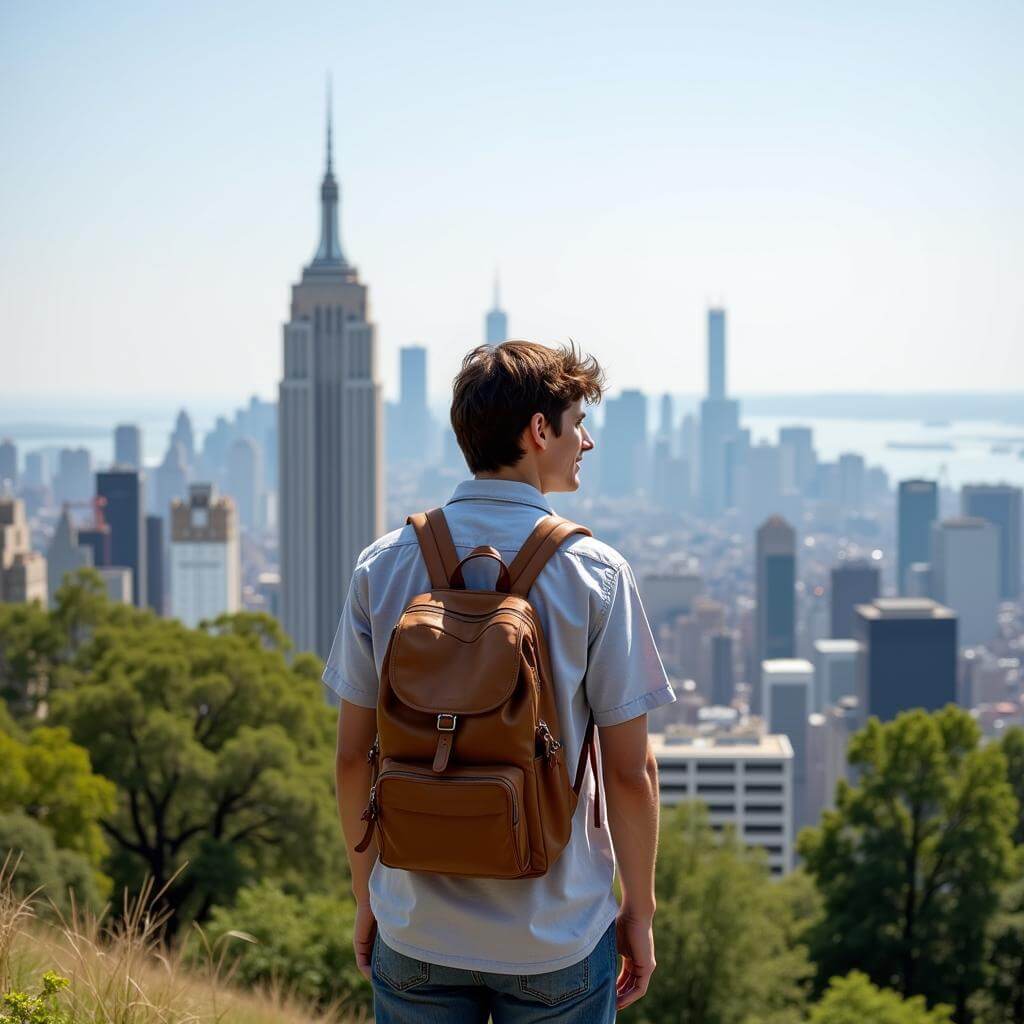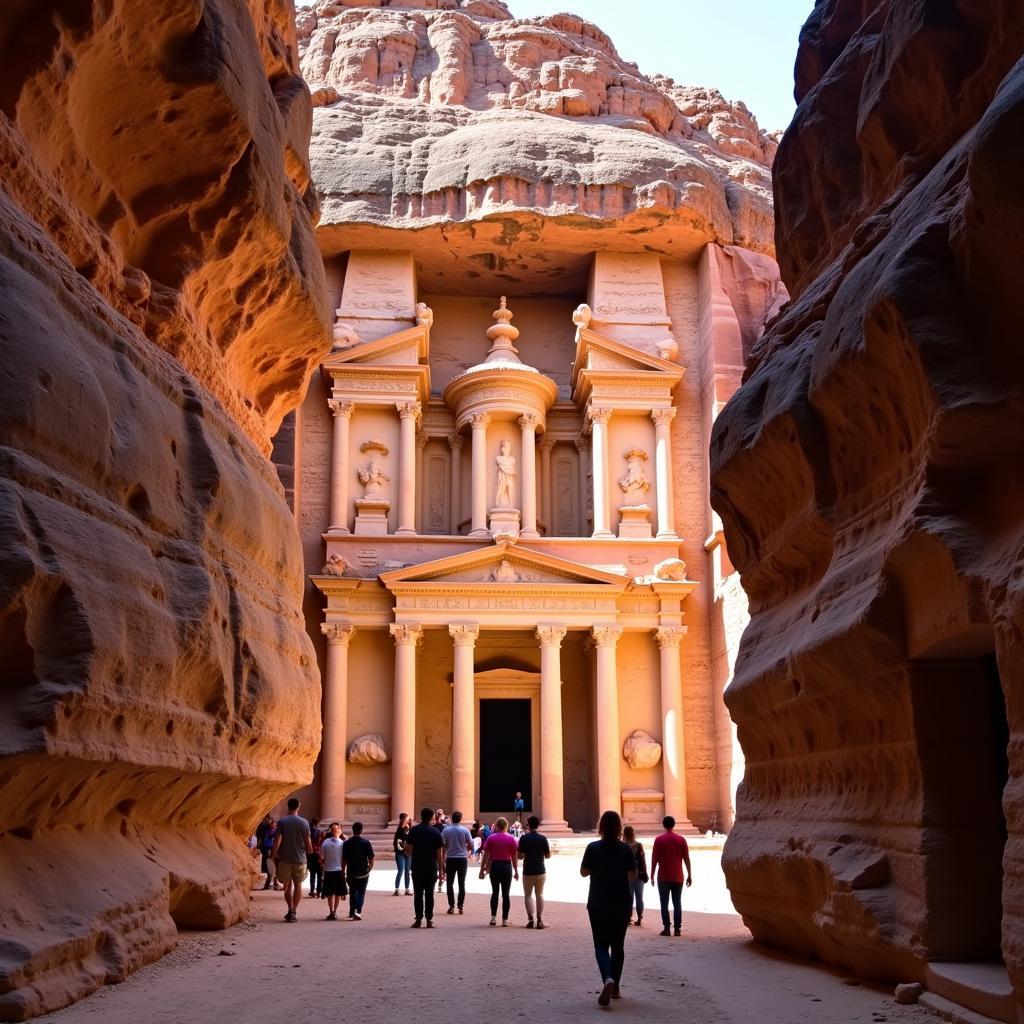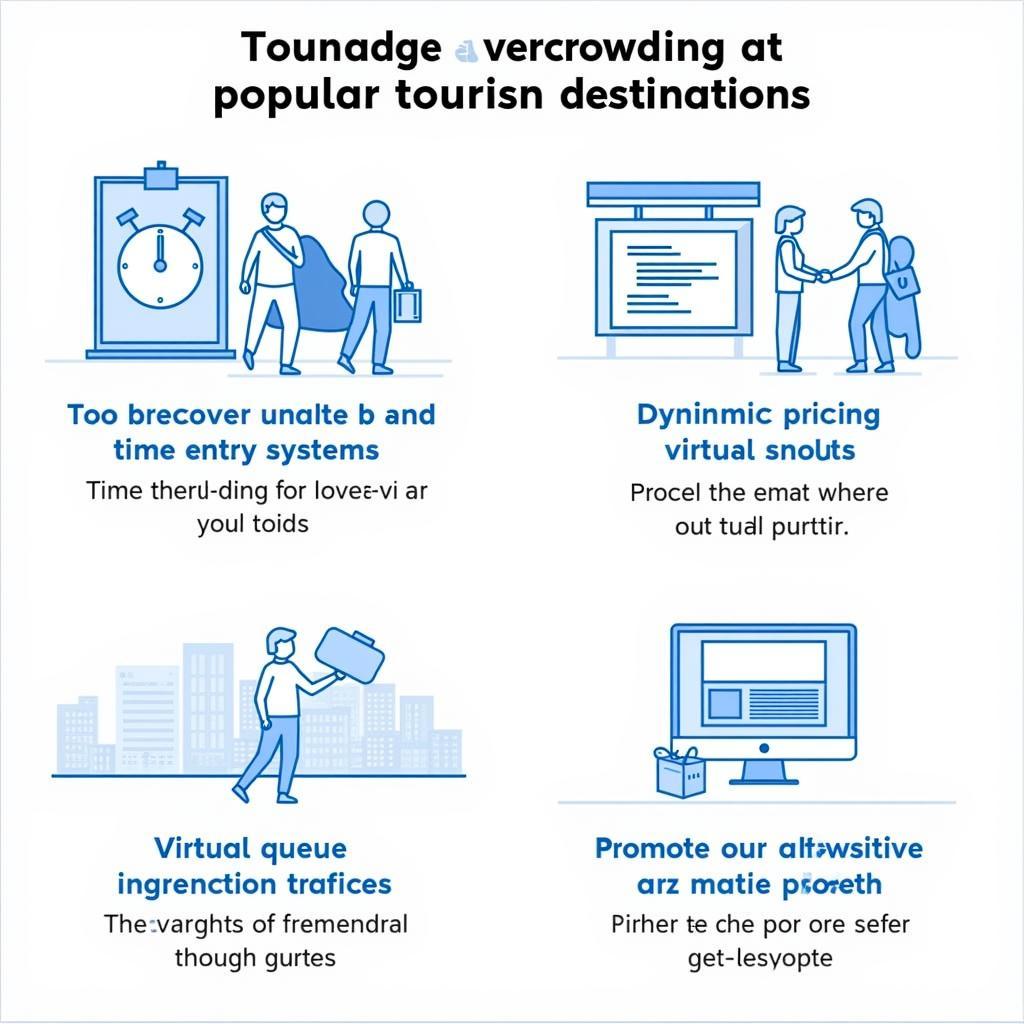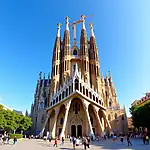Tourism is a popular topic in IELTS Speaking tests, frequently appearing in all three parts of the exam. Being able to eloquently describe a tourist spot can significantly boost your score. This article will guide you through answering questions about recommending a tourist spot, providing sample answers for different band scores.
Part 1: Introduction and Interview
In this section, the examiner may ask general questions about tourism and travel. Here’s a sample question with a suggested answer:
Q: Do you enjoy visiting tourist attractions?
A (Band 8-9): Absolutely. I find exploring tourist attractions to be an enriching experience. Not only do they offer insights into the local culture and history, but they also provide a fantastic opportunity to meet people from diverse backgrounds. However, I prefer off-the-beaten-path destinations to avoid the crowds and get a more authentic experience.
 Tourist enjoying view of famous landmark
Tourist enjoying view of famous landmark
Part 2: Long Turn
Here’s a sample cue card related to describing a tourist spot:
Describe a tourist spot you would recommend
You should say:
- Where it is
- What people can do there
- Why you would recommend it
- And explain how this place became popular with tourists
Sample Answer (Band 6-7):
I’d like to recommend a tourist spot called Ha Long Bay, located in northern Vietnam. It’s a stunning natural wonder with thousands of limestone islands rising from the emerald waters of the Gulf of Tonkin.
Visitors can enjoy various activities there. They can take a cruise around the bay to admire the scenery, go kayaking to explore hidden caves, or visit floating villages to learn about local life. Some people also enjoy swimming and sunbathing on the small beaches.
I’d recommend this place because it offers a unique combination of natural beauty and cultural experiences. The landscape is breathtaking, and the local cuisine is delicious. It’s also a great place to relax and escape from the busy city life.
Ha Long Bay became popular with tourists due to its UNESCO World Heritage status and its appearance in several international movies. Word of mouth from satisfied visitors has also contributed to its growing popularity over the years.
Sample Answer (Band 8-9):
I’d be delighted to recommend an awe-inspiring tourist destination – the ancient city of Petra in Jordan. This archaeological marvel is nestled in a secluded valley, approximately 150 miles south of Amman, the capital city.
Visitors to Petra can immerse themselves in a plethora of activities. They can embark on a mesmerizing journey through the narrow Siq, a natural gorge flanked by towering cliffs, which dramatically reveals the iconic Treasury building. Adventure enthusiasts can hike up to the Monastery for panoramic views or explore the intricate network of tombs and temples carved into the rose-red cliffs. For a truly unique experience, I’d suggest attending the Petra by Night show, where the ancient city is illuminated by thousands of candles.
I wholeheartedly recommend Petra for several compelling reasons. Firstly, its extraordinary architecture and rich history make it a feast for the eyes and the mind. The site offers a rare glimpse into the ingenuity of the ancient Nabataean civilization. Moreover, the sheer scale and grandeur of the rock-cut facades are simply breathtaking and unlike anything else in the world.
Petra’s rise to fame as a tourist hotspot can be attributed to several factors. Its designation as a UNESCO World Heritage site in 1985 significantly boosted its international profile. The city gained further popularity after being featured in the film “Indiana Jones and the Last Crusade” in 1989, which sparked global curiosity. Additionally, Petra’s inclusion in various “New Seven Wonders of the World” lists has cemented its status as a must-visit destination for travelers from around the globe.
 Petra ancient city in Jordan with tourists
Petra ancient city in Jordan with tourists
Follow-up Questions:
Q: How has tourism affected this place?
A (Band 8-9): Tourism has had a profound impact on Petra. On the positive side, it has significantly boosted the local economy, providing employment opportunities and improving infrastructure. However, the influx of visitors has also led to concerns about preservation. The Jordanian government has implemented strict conservation measures to protect the site from erosion and damage caused by foot traffic. They’ve also introduced sustainable tourism practices to balance economic benefits with environmental protection.
Q: Do you think it’s important for tourists to learn about the history of the places they visit?
A (Band 8-9): Absolutely. I believe that understanding the history of a place enriches the travel experience immensely. It allows tourists to appreciate the significance of what they’re seeing and fosters a deeper connection with the destination. Learning about history also promotes cultural sensitivity and can help travelers behave more respectfully towards local customs and traditions. Moreover, it transforms a simple sightseeing trip into an educational journey, making the experience more meaningful and memorable.
Part 3: Two-way Discussion
Q: How do you think tourism will change in the future?
A (Band 6-7): I think tourism will change a lot in the future. With technology improving, we might see more virtual reality tours where people can experience places without actually going there. Also, I believe eco-tourism will become more popular as people become more aware of environmental issues.
A (Band 8-9): I anticipate that tourism will undergo significant transformations in the coming years. We’re likely to witness a surge in sustainable and responsible travel as environmental consciousness grows. This might manifest in the form of carbon-neutral holidays or community-based tourism initiatives that directly benefit local populations. Additionally, advancements in technology could revolutionize the travel experience. We might see the rise of immersive augmented reality guides that provide real-time information about historical sites or personalized AI travel assistants that can curate unique experiences based on individual preferences. The concept of space tourism might also transition from science fiction to reality, offering unprecedented opportunities for adventure seekers.
Q: What can be done to protect popular tourist destinations from overcrowding?
A (Band 6-7): To protect popular tourist spots from overcrowding, governments could limit the number of visitors allowed each day. They could also increase ticket prices during peak seasons to discourage too many people from coming at once. Another idea is to promote alternative attractions nearby to spread out the tourists.
A (Band 8-9): Addressing overcrowding at popular tourist destinations requires a multifaceted approach. Implementing a dynamic pricing strategy that adjusts entry fees based on demand could help distribute visitor numbers more evenly throughout the year. Authorities could also introduce timed entry systems or mandatory advance bookings to regulate the flow of tourists. Another effective strategy would be to diversify tourist offerings by developing and promoting lesser-known attractions in the vicinity, thereby alleviating pressure on overcrowded hotspots. Furthermore, leveraging technology to create virtual queuing systems or real-time crowd monitoring apps could enhance visitor experience while managing capacity. Ultimately, fostering a culture of responsible tourism through education and awareness campaigns is crucial for long-term sustainability.
 Overcrowded tourist destination management strategies
Overcrowded tourist destination management strategies
Key Vocabulary and Phrases for High Scores
-
Awe-inspiring /ˈɔː ɪnˌspaɪərɪŋ/ (adj): Causing feelings of awe or admiration.
Example: The Grand Canyon’s vast expanse is truly awe-inspiring. -
Immerse oneself /ɪˈmɜːs wʌnˈself/ (phrasal verb): To become completely involved in something.
Example: Travelers can immerse themselves in local culture by staying with host families. -
Breathtaking /ˈbreθteɪkɪŋ/ (adj): Astonishing or awe-inspiring in quality, so as to take one’s breath away.
Example: The view from the mountaintop was absolutely breathtaking. -
Off the beaten path (idiom): In or to an isolated, unexplored, or little-known place.
Example: We prefer to explore off the beaten path destinations to avoid tourist crowds. -
Sustainable tourism /səˈsteɪnəbl ˈtʊərɪzəm/ (noun): Tourism that respects both local people and the traveler, cultural heritage and the environment.
Example: Many countries are now focusing on promoting sustainable tourism to protect their natural resources.
Examiner’s Advice
To achieve a high score in the IELTS Speaking test when describing a tourist spot:
- Use a variety of descriptive language: Incorporate adjectives and adverbs to make your description vivid and engaging.
- Demonstrate a range of grammatical structures: Use a mix of simple, compound, and complex sentences to showcase your language proficiency.
- Incorporate relevant vocabulary: Use topic-specific words and phrases related to tourism and travel.
- Provide detailed examples: Support your points with specific examples or personal experiences to add depth to your answers.
- Maintain fluency: Practice speaking on various topics to improve your ability to speak at length without hesitation.
- Show critical thinking: In Part 3, analyze questions from different perspectives and provide well-reasoned opinions.
Remember, consistent practice and exposure to English through various media will help you improve your speaking skills and confidence for the IELTS test.
For more practice, you might want to describe a place you visited with stunning views or describe a memorable experience during a holiday. These topics are closely related and can help you build a wider vocabulary for discussing travel and tourism.


